

ODYSSEY/Rome. Horrible Histories: Roman Conscription. List of Roman deities. A vast number of ancient Roman deities are known by name.
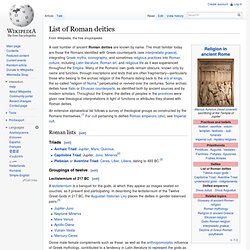
The most familiar today are those the Romans identified with Greek counterparts (see interpretatio graeca), integrating Greek myths, iconography, and sometimes religious practices into Roman culture, including Latin literature, Roman art, and religious life as it was experienced throughout the Empire. Many of the Romans' own gods remain obscure, known only by name and function, through inscriptions and texts that are often fragmentary—particularly those who belong to the archaic religion of the Romans dating back to the era of kings, the so-called "religion of Numa," perpetuated or revived over the centuries. Some archaic deities have Italic or Etruscan counterparts, as identified both by ancient sources and by modern scholars.
Ancient Roman Laws. Since the days of the Law of the Twelve Tables, developed during the early republic, the Roman legal system was characterized by a formalism that lasted for more than 1.000 years.

Early Roman law was drawn from custom and statutes, but later during the times of the empire, the emperors asserted their authority as the ultimate source of law. Their edicts, judgments, administrative instructions, and responses to petitions were all collected with the comments of legal scholars. DengeDenge Online Magazine. Nude Figures and Erotic Images on Ancient Coins.

These coins were made in Rome around the first century BC and they were paying for certain services, or they went as usual? Digital Atlas of the Roman Empire. Proverbs, Quotes, and Sayings of Ancient Rome. There are many sayings used in the Roman world which are interesting and fun to know.

Many reflect the attitude of the culture at that time, and of the person who was quoted. Knowing these quotes can assist in getting immersed in the culture of a game, and for those interested, in role playing. Greetings and Goodbyes This is fairly simple to remember. The most common of Roman greetings was “Salve!” Goodbye was often said as “Vade en pace” which means “go in peace”, though that was a bit lengthy and formal.
The Roman Empire. Or Republic. Or...Which Was It?: Crash Course World History #10. Seven Wonders of Ancient Rome. Rome: Women In Rome (HBO) Spartacus and class struggle in ancient Rome. Spartacus and class struggle in ancient Rome Graham Stevenson Roman agriculture was originally dominated by free peasants, each cultivating land for their own family needs.
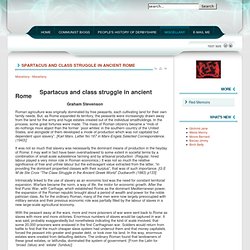
The Command Structure. The Roman Senate. Roman Senate. Legions. Choose a name and number for your Legion (consult history books if authenticity is a concern).

Create a Legion banner (Signum). Attend at least 20 medieval events annually. Own and wear torso armor. Submit Legion’s attendance to Dominus or the Quaestor in writing at every battle for records. Roman Centurion. You are not merely a competent soldier; you are an absolute bad-ass.
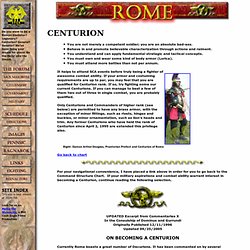
Behave in and promote believable characterization through actions and raiment. You understand and can apply fundamental strategic and tactical concepts. You must own and wear some kind of body armor (Lorica). You must attend more battles than not per annum. Go back to chart For your navigational convenience, I have placed a link above in order for you to go back to the Command Structure Chart. Go back to chart. Roman Legionary. Roman Military Tribune. A Tribune is a Legion commander who is either of Centurion rank or Senatorial status.
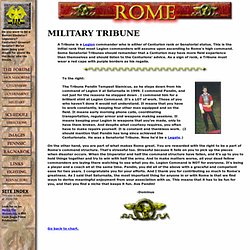
This is the initial rank that most Legion commanders will assume upon ascending to Rome's high command. Some Senatorial Tribunes should remember that a Centurion may have more field experience than themselves and should listen to the Centurions' advice. As a sign of rank, a Tribune must wear a red cape with purple borders as his regalia. On the other hand, you are part of what makes Rome great. You are rewarded with the right to be a part of Rome's command structure. Go back to chart. Punic Wars - Ancient History. Over the next decades, Rome took over control of both Corsica and Sardinia as well, but Carthage was able to establish a new base of influence in Spain beginning in 237 B.C., under the leadership of the powerful general Hamilcar Barca and, later, his son-in-law Hasdrubal.

According to Polybius and Livy in their histories of Rome, Hamilcar Barca, who died in 229 B.C., made his younger son Hannibal swear a blood oath against Rome when he was just a young boy. Upon Hasdrubal’s death in 221 B.C., Hannibal took command of Carthaginian forces in Spain. Two years later, he marched his army across the Ebro River into Saguntum, an Iberian city under Roman protection, effectively declaring war on Rome. Fall of The Roman Empire...in the 15th Century: Crash Course World History #12.
Roman Empire "Imperium Romanum" ( Ancient Rome ) Roman Republic. The Roman Republic (Latin: Res Pvblica Romana) was the period of the ancient Roman civilization when the government operated as a republic.
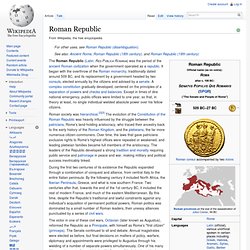
It began with the overthrow of the Roman monarchy, traditionally dated around 509 BC, and its replacement by a government headed by two consuls, elected annually by the citizens and advised by a senate. A complex constitution gradually developed, centered on the principles of a separation of powers and checks and balances. Except in times of dire national emergency, public offices were limited to one year, so that, in theory at least, no single individual wielded absolute power over his fellow citizens.